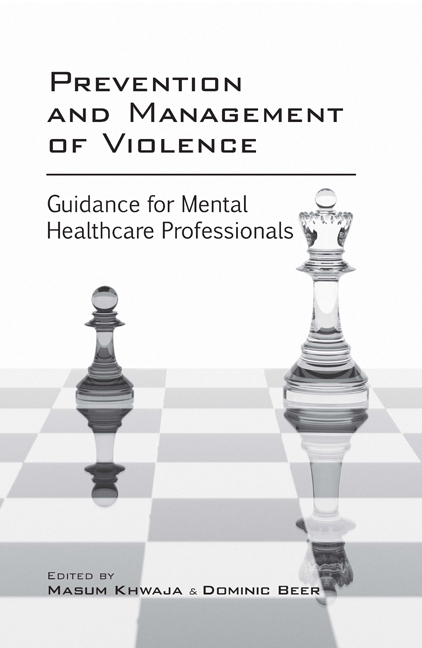Book contents
- Frontmatter
- Dedication
- Contents
- Abbreviations
- List of boxes and tables
- Working group
- Executive summary and recommendations
- 1 Legislation relevant to the management of violence by persons with mental disorders
- 2 Safeguarding vulnerable adults and children exposed to violence
- 3 Risk assessment and management
- 4 Risk prevention and non-pharmacological management of violence in acute settings
- 5 Use of medication and ECT in the management of violence
- 6 Post-incident management
- 7 Management of the risk of violence in the community
- 8 Management of violence in older adults
- 9 Management of violence in people with intellectual disability
- 10 Management of violence in prisons
- 11 Liaison with the police, Crown Prosecution Service and MAPPA
- 12 Information-sharing with victims of crime committed by persons with mental disorders
- 13 Clinical governance
- Appendix Organisations that victims of crime can contact
- Index
9 - Management of violence in people with intellectual disability
- Frontmatter
- Dedication
- Contents
- Abbreviations
- List of boxes and tables
- Working group
- Executive summary and recommendations
- 1 Legislation relevant to the management of violence by persons with mental disorders
- 2 Safeguarding vulnerable adults and children exposed to violence
- 3 Risk assessment and management
- 4 Risk prevention and non-pharmacological management of violence in acute settings
- 5 Use of medication and ECT in the management of violence
- 6 Post-incident management
- 7 Management of the risk of violence in the community
- 8 Management of violence in older adults
- 9 Management of violence in people with intellectual disability
- 10 Management of violence in prisons
- 11 Liaison with the police, Crown Prosecution Service and MAPPA
- 12 Information-sharing with victims of crime committed by persons with mental disorders
- 13 Clinical governance
- Appendix Organisations that victims of crime can contact
- Index
Summary
Violent behaviour displayed by individuals with intellectual disability is one of the biggest challenges to services. It is one of many manifestations of challenging behaviour. It may include punching, slapping, pushing, pulling, kicking, pinching, scratching, pulling hair, biting, head butting, using weapons, choking and throttling, and sexual violence. Violence can occur in a variety of settings: in in-patient and community-based settings such as family homes, settings run by statutory organisations as well as those in the private and voluntary sector. Children with intellectual disability and severe challenging aggressive behaviour may be placed in residential schools.
Violent behaviour has many serious consequences for both individuals with intellectual disability and formal and informal carers, and is a major obstacle to the individual's social integration. Violent behaviour is also one of the main reasons for referral to mental health professionals and services. Often violent behaviour leads to multiple admissions to institutions and psychiatric facilities. Staff working with individuals with intellectual disability who experience challenging behaviour, including violent behaviour, may experience high levels of stress and burnout (Jenkins et al, 1997; Male & May, 1997).
Epidemiology
Rates of violent and aggressive behaviour vary considerably across studies, ranging from 2% to 51% of those with intellectually disability population (Borthwick-Duffy, 1994; Emerson et al, 2001; Crocker et al, 2006). The differences in the prevalence of violence across studies were due to methodological variations that included factors such as study settings (e.g. institutional v. community), level of intellectual disability (profound intellectual disability to mild intellectual disability, as well as borderline intellectual disability), time-span surveyed (e.g. past month, past year or more) and age group (children, adolescents or adults) (McClintock et al, 2003).
Aetiology
Biological factors
Violent behaviour in people with intellectual disability can be driven by factors which also apply to those without intellectual disability (e.g. coexistent mental illness, substance misuse, certain personality disorders). Additional inherent factors arising from the intellectual disability such as poor regulation of frustration and anxiety can compound or act independently to trigger violent behaviour (Bhaumik et al, 2005).
Some specific biological factors which have been investigated with regard to their role in precipitating aggression in people with intellectual disability include epilepsy (Creaby et al, 1993), pain (Tenneij & Koot, 2008) and menstruation (Rodgers et al, 2006).
- Type
- Chapter
- Information
- Prevention and Management of ViolenceGuidance for Mental Health Professionals, pp. 89 - 95Publisher: Royal College of PsychiatristsFirst published in: 2017

